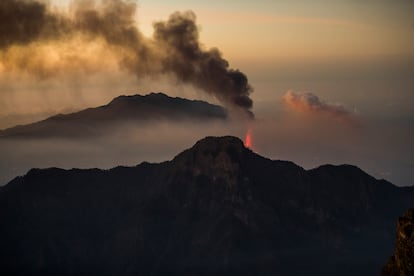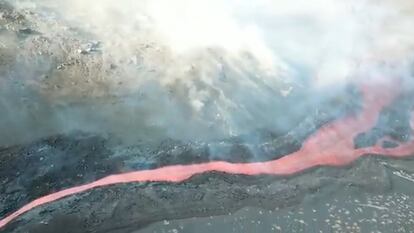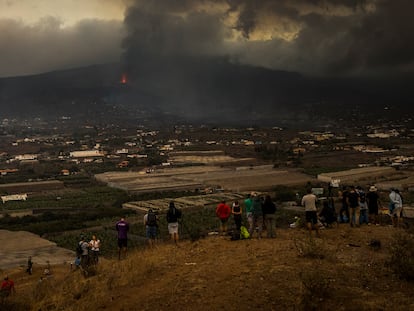La Palma volcano ceases to emit lava, smoke and ash but risk of molten rock reaching sea remains
Four residential areas have been confined due to the danger, with residents instructed to stay in their homes with the doors and windows closed
Exactly a week after the new volcano on the Canary Island of La Palma began to erupt, the lava flow reactivated yesterday, speeding up the advance of the molten rock toward the sea. The developments forced the urgent confinement of four residential areas last night, due to the danger of toxic gases emerging when the lava meets the seawater. The lava could reach the water at some point on Monday, experts said.
People who live in the four areas affected were instructed to stay in their homes with the doors and windows closed, until the situation could be evaluated on Monday. The crisis committee on the island reported last night that the lava had now passed the neighborhood of Todoque, which was evacuated last week, and was now 1,600 meters from the coast after crossing the LP-213 road – a key route for accessing the south of the island.
Unexpectedly, however, on Monday morning the volcano ceased emitting lava, smoke and ash for a little over two hours, as could be seen in the live video images being broadcast by Televisión Canaria. Seismic activity fell to minimal levels on Monday morning, which could mean that the magma was meeting less resistance as it emerged from the volcano, or that less material was being expelled. The Institute of Geosciences in Madrid (IGN) warned that the situation would have to be closely monitored, as the “scenario can change rapidly.” The IGN added that it is normal for volcanic activity to cease temporarily, but said the suddenness of the change in behavior was strange.
The president of La Palma’s island council, Mariano Hernández Zapata, explained at a press conference late on Sunday evening that the south flank of the lava flow had rejoined the main flank in Todoque, which is part of Los Llanos de Aridane municipality. That accelerated the flow of the molten rock. The lava was last night following the route of the main flow and was moving at an average of 100 meters per hour. It was, the president explained, moving faster because it was hotter, “given that it is coming from a deeper part of the volcano, some 10 kilometers, which makes its fluidity greater.”
The European Union’s Copernicus alert system, meanwhile, also confirmed that the two separate tongues had joined together. The director of the National Geographic Institute (IGN), María José Blanco, had calculated that the lava was moving at a speed of between 100 and 200 meters an hour, “although there is no exact figure, just estimates.”
The main evidence of this reactivation was the collapse of the church bell tower in Todoque, a building that fire crews had tried to save last week by digging trenches using heavy machinery. According to Hernández Zapata, the lava reappeared aggressively and swept away “distinguishing marks” from the municipality. As well as the church, the local health center and the neighborhood association were both lost to the natural phenomenon.
The lava had been stationary for two days, and started moving due to two new vents that appeared on Friday and that proceed from deeper parts of the volcano, where the temperature is estimated at 1,200ºC, according to scientists cited by the team of experts monitoring the phenomenon, the Volcano Risk Prevention Plan (Pevolca). The new eruption of lava came at a time when some residents of Todoque were collecting belongings from their properties, something that forced them to quickly evacuate.
The president of the island council stated that the lava was continuing its “fast advance toward the sea.” Its most likely route will see the lava traverse wasteland and pastures, dotted with small homes.

One of the main concerns of the island council was that the lava reach “the only southern access route, the coastal road,” something that would make it difficult to attend to and supply municipalities such as Fuencaliente. This would cause yet more destruction and add to the already high cost of the damage so far: estimates put the total at more than €20 million, according to data from the island council.
The technical director of Pevolca, Miguel Ángel Morcuende, reported on Sunday that the intensity of the seismic activity had eased and that it was also taking place at a greater depth of around 10 kilometers. This permitted around 200 residents of Tacande de Arriba, Tacande de Abajo and Tajuya to be able to return to their homes.
Also on Sunday, more ash reached municipalities further away from the volcano, such as Santa Cruz de La Palma, Villa de Mazo, Breña Alta, Breña Baja and Puntallana, given that winds were coming from the southwest at altitudes of more than 1,400 meters.
The falling ash prompted classes to be suspended in the municipalities of Santa Cruz de La Palma and Breña Alta, as well as in Los Llanos de Aridane, El Paso and Tazacorte, where schools have been closed since the eruption started.
The winds did not just bring ash with them. The explosions from the volcano could also be heard in the eastern area of the island, where the capital is located, Santa Cruz de La Palma, as well as the main tourism site on the island, Los Cancajos. The explosions were particularly strong in the five-kilometer radius from the volcano, prompting Morcuende to call for “extreme precautions” among the public, in particular staying away from windows when this activity is taking place.
Morcuende also sought to convey a message of calm. “We are not in a state of high alert, far from it,” he said, adding that the situation was “completely safe.” The total number of properties that have been destroyed by the lava flow now stands at between 500 and 600, according to estimates by EL PAÍS. This includes houses, garages and industrial or farming buildings.
Any chance of acid rain was ruled out yesterday for the coming 24 hours. What’s more, Pevolca has stated that the serious effects of acid rain on vegetation are related to the persistence of such a phenomenon, meaning that a short episode would not have an effect. The average levels of sulfur dioxide detected by the monitoring network show that the air quality is good.
English version by Simon Hunter.
Tu suscripción se está usando en otro dispositivo
¿Quieres añadir otro usuario a tu suscripción?
Si continúas leyendo en este dispositivo, no se podrá leer en el otro.
FlechaTu suscripción se está usando en otro dispositivo y solo puedes acceder a EL PAÍS desde un dispositivo a la vez.
Si quieres compartir tu cuenta, cambia tu suscripción a la modalidad Premium, así podrás añadir otro usuario. Cada uno accederá con su propia cuenta de email, lo que os permitirá personalizar vuestra experiencia en EL PAÍS.
¿Tienes una suscripción de empresa? Accede aquí para contratar más cuentas.
En el caso de no saber quién está usando tu cuenta, te recomendamos cambiar tu contraseña aquí.
Si decides continuar compartiendo tu cuenta, este mensaje se mostrará en tu dispositivo y en el de la otra persona que está usando tu cuenta de forma indefinida, afectando a tu experiencia de lectura. Puedes consultar aquí los términos y condiciones de la suscripción digital.
More information

Volcanic activity increases on La Palma, prompting new evacuations and flight cancelations
Últimas noticias
Most viewed
- Sinaloa Cartel war is taking its toll on Los Chapitos
- Oona Chaplin: ‘I told James Cameron that I was living in a treehouse and starting a permaculture project with a friend’
- Reinhard Genzel, Nobel laureate in physics: ‘One-minute videos will never give you the truth’
- Why the price of coffee has skyrocketed: from Brazilian plantations to specialty coffee houses
- Silver prices are going crazy: This is what’s fueling the rally











































